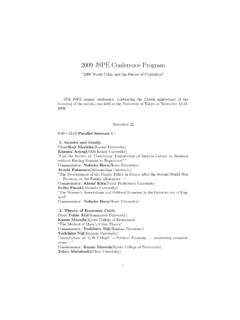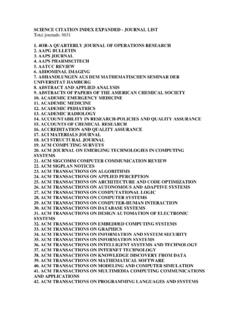Transcription of Probabilistic Methods and Stochastic Hydrology
1 UNESCO EOLSSSAMPLE CHAPTERSHYDRAULIC STRUCTURES, EQUIPMENT AND WATER DATA ACQUISITION SYSTEMS Vol. I - Probabilistic Methods and Stochastic Hydrology - G. G. S. Pegram Encyclopedia of Life Support Systems (EOLSS) Probabilistic Methods AND Stochastic Hydrology G. G. S. Pegram Civil Engineering Department, University of Natal, Durban, South Africa Keywords : Stochastic Hydrology , statistical Methods , model selection, Stochastic models, single sites, multiple sites, random fields, space-time, simulation, forecasting, data infilling, data repairs, disaggregation. Contents 1. Introduction 2. Statistics, Probability and Model Selection Statistics and Statistical Methods Probability Distribution Functions Continuous Distributions Discrete Distributions Model Selection Moment Matching L-Moments Maximum Likelihood 3.
2 Stochastic Models Data Types Rainfall Data Stream-Flow Data Single-Site Models Continuous-State, Discrete-Time Models Discrete-State, Continuous-Time, Models Discrete-State, Discrete-Time Models Multi-Site Models Continuous-State, Discrete-Time Models Discrete-Space, Discrete-Time Models Random-Field Models of Spatial Processes Gaussian Field Models Fractal Models Space-Time Models Simulation Forecasting Stochastic Forecasting Data Infilling and Repair Uni-Variate Time Series Spatial In-Filling Disaggregation 4. Future Possibilities Glossary Bibliography Biographical Sketch UNESCO EOLSSSAMPLE CHAPTERSHYDRAULIC STRUCTURES, EQUIPMENT AND WATER DATA ACQUISITION SYSTEMS Vol.
3 I - Probabilistic Methods and Stochastic Hydrology - G. G. S. Pegram Encyclopedia of Life Support Systems (EOLSS) Summary Stochastic Hydrology is the statistical branch of Hydrology that deals with the Probabilistic modeling of those hydrological processes which have random components associated with them. A Stochastic hydrologist will suggest appropriate models and means of estimating the parameters of those models, and will go on to suggest techniques for simulating the processes and perhaps performing forecasts using those models. Testing the validity of the models is an important final step before the model is applied in practice. Phenomena whose models are described in this article are rainfall and stream flow, seen as both as point and spatial processes.
4 The content is introductory in nature but attempts to offer as wide a spread of applications as may be useful, keeping the mathematical development at an expository level. 1. Introduction Hydrology is the science that attempts to catalogue, understand and model the processes of precipitation of water and its passage through, over and under the earth s land surfaces. Hydrology has strong links with other study areas, such as ecology, geology, meteorology, economics, politics, social science, and law. This article addresses the modeling, estimation, simulation and forecasting of two of the more variable processes in Hydrology precipitation and stream flow. These two processes are selected from a list of all hydrological processes which extends to include evaporation, infiltration and groundwater flow, and require the measurement, cataloguing and modeling of temperature, humidity, wind velocity, radiation, geology, soil and vegetation cover, geomorphology, etc.
5 The restriction of the attention in this article to rainfall and stream flow is justified because these constitute the primary variables of interest to water resources engineers (see Fluids at Rest and in Motion; Measurement of Free Surface Flow). The problem of the water resources engineer is that water is either too abundant, too lacking, or too dirty. Storage of water in reservoirs behind dams on rivers is a way of saving excess water from a time of plentiful supply, to be made available during periods of low flow, which can occur seasonally or over some years. Estimates of reliability of the provision of water have to be made, together with the cost of supply in relation to its benefit.
6 The dams and associated structures involved in the storage of water have to be protected from natural hazards, such as floods and earthquakes, and the chance that these might occur has to be assessed. These are tasks that face the water resources engineer, who has to understand how to extract the relevant information from the available rainfall and river flow data (see Hydrological Data Acquisition Systems). The understanding and modeling of the processes, ipso facto, depends on what has been observed in the past, remembering that the future is not what the past used to be. The possibility of change in climate must be anticipated, modeled, and accounted for. Short-term precipitation forecasts, in hours for flash flooding, days for weather bulletins, and months for agricultural scientists, is a field of endeavor with possibly rich rewards, and finds its place in Hydrology (see Hydraulic Methods and Modeling).
7 UNESCO EOLSSSAMPLE CHAPTERSHYDRAULIC STRUCTURES, EQUIPMENT AND WATER DATA ACQUISITION SYSTEMS Vol. I - Probabilistic Methods and Stochastic Hydrology - G. G. S. Pegram Encyclopedia of Life Support Systems (EOLSS) Stochastic models are used to describe the physical processes that are observed, and about which, data are recorded. Modeling is a process undertaken to understand and to find associations between processes, so that predictions of behavioral response can be conjectured and tested. Simulating the natural processes to produce possible future scenarios offers a means of testing the reliability of structures or schemes, and adds value to the information inherent in the measured data. These data sets are often woefully short, inaccurately recorded, or at worst, are completely lacking, in which case the Stochastic hydrologist is powerless to invent information.
8 However, by careful inference, interpolation and cautious extrapolation, it is sometimes possible to transfer information to ungauged locations; this is an ongoing endeavor (see Applied Hydraulics, Flow Measurement and Control). In this article, physical processes as such are not described, but rather the modeling of the data that present themselves in various forms in measurement of rainfall and stream flow. The branch of Hydrology which deals with these tools is called Stochastic Hydrology . The word Stochastic is a statistical term describing time series when they are not purely random, but exhibit dependence in time. Physical data collection is described elsewhere (see Hydrological Data Acquisition Systems). There are two main sections following this introduction: Section 2 deals with Statistics, Probability and Model Selection; and Section 3 addresses Stochastic Models.
9 2. Statistics, Probability and Model Selection This section presents some statistics and statistical tools, probability distributions, and techniques of model selection, which are commonly used in Stochastic Hydrology . Statistics are numbers derived from data in such a way as to summarize neatly the major features of the behavior of the data; examples are location, spread, shape, bounds, etc. These descriptors include the mean, median, variance, skewness, and range of data, which can be calculated independently of any assumptions about the underlying distribution. They may suggest appropriate probability models (as distribution functions) which might describe or explain the way the data present themselves.
10 Probability distribution functions are chosen to represent data derived from observations on processes in an economical way using a few parameters to define the functions. The exercise of choosing a suitable function is dealt with under model selection. Statistics and Statistical Methods Well-known statistics such as the mean and variance of a sample of data are the simplest of the quantities to derive. The mean is the average, ( , the sum of the data divided by the number of data) while the variance is the average of the squares of the differences of the data from their sample mean. The second statistic is an example of a product moment. A statistic which is more difficult to calculate is the median.














